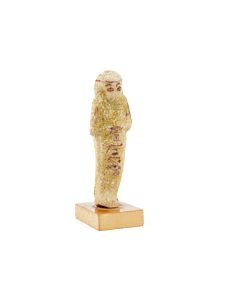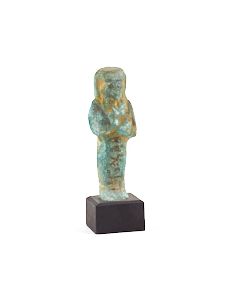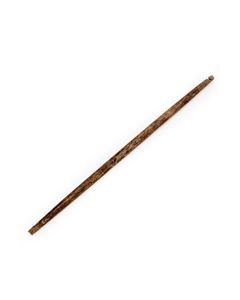Search results for: 'Stone to'
-
 Egyptian stone beaker
Egyptian stone beakerThe elegant stone vase was probably used as an ointment vessel. 5th to 6th dynasty of ancient Egypt, Old Kingdom.
Price: on request Egyptian model vessels of a founding ceremony
Egyptian model vessels of a founding ceremonyA group of seven miniature bowls and three miniature vases made of clay. Once filled with offerings and used ritually during a foundation stone laying ceremony. Dating to the Old Kingdom, around 2500 BC.
Price: on request Slender Egyptian stone beaker
Slender Egyptian stone beakerThe small and tall stone vessel is made of alabaster. From the collection of Egyptologist Professor Wiedemann.
Price: on request Egyptian Kohl vessel
Egyptian Kohl vesselThe small stone pot of nicely polished granite was used for Kohl, the eye cosmetic of the ancient Egyptians. From the time between Middle Kingdom and New Kingdom.
Price: on request Egyptian chalice
Egyptian chaliceThe thin-walled stone cup is reminiscent of a lotus bud. From the collection of Egyptologist Professor Wiedemann. 18th dynasty of Ancient Egypt.
Price: on request Stone Age bow scraper from Egypt
Stone Age bow scraper from EgyptThe Paleolithic tool is of beautiful shape and color. Thebes has been handed down as the place of origin. Including old museum display.
Price: on request Lapis lazuli head of a pharao
Lapis lazuli head of a pharaoExtremely rare finely carved royal head made of blue stone with bronze beard. Late Period to Ptolemaic period of ancient Egypt.
€3,450 Three neolithic arrowheads from Egypt
Three neolithic arrowheads from EgyptThe Stone Age points are beautifully crafted, with finely serrated edges. From a 100 year old museum collection.
Price: on request Paleolithic hand axe of Homo Erectus
Paleolithic hand axe of Homo ErectusBig hand axe from Niger. Made during the Old Stone Age, around 200,000 years ago. The universal stone age tool could be use as a borer or cutting tool.
Price: on request Egyptian heart scarab
Egyptian heart scarabBig beetle stone from the Late Period of Ancient Egypt. Scarabs of this kind have been placed next to the heart on mummies. Nice mint green fayence.
Price: on request Large paleolithic hand axe
Large paleolithic hand axePrehistoric stone tool made of wonderfully banded stone. It was the universal tool of the older Stone age and could be used as a borer or a cutter. From a Swiss museum collection. Found in Morocco, North Africa.
Price: on request Paleolithic hand axe
Paleolithic hand axeSmall prehistoric stone tool. It was the universal tool of the older Stone age and could be used as a borer or a cutter. From a 100 year old museum collection.
Price: on request Paleolithic hand axe
Paleolithic hand axeSmall prehistoric stone tool. It was the universal tool of the older Stone age and could be used as a borer or a cutter. From a 100 year old museum collection.
Price: on request Flint blade and stone mould
Flint blade and stone mouldInteresting group of two artefacts. A Neolithic flint blade from Egypt and a Bronze Age mould for casting or hammering metal.
Price: on request Small terracotta ushabti
Small terracotta ushabtiSimple funerary figurine from the 22nd to 25th dynasty of ancient Egypt. Part of a group of three figures that are said to be from the same grave.
Price: on request Ushabti of the 22nd dynasty
Ushabti of the 22nd dynastyRemarkable Egyptian funerary statuette made of green faience with black paint. Probably from Tanis and made during the 22nd dynasty.
Price: on request Small shabti
Small shabtiNice turquoise faience figurine with black paint. From the 22nd to 25th dynasty of ancient Egypt.
Price: on request Small Egyptian ushabti
Small Egyptian ushabtiFunerary statuette from the Third Intermediate Period of ancient Egypt. Orange-brown clay with green faience.
Price: on request Egyptian ushabti for Nisi-ta-udjat-achet
Egyptian ushabti for Nisi-ta-udjat-achetInteresting figurine made of green faience with black paint. A typical funerary statuette from the Third Intermediate Period of ancient Egypt.
Price: on request Egyptian ushabti
Egyptian ushabtiFunerary statuette made of turquoise faience with black paint. 21st dynasty of ancient Egypt.
Price: on request Egyptian spindle shaft made of wood
Egyptian spindle shaft made of woodExceptionally rare main piece of a hand spindle. A find from Thebes in Upper Egypt. From the reign of pharao Senusret II, around 1840 BC.
Price: on request Egyptian ushabti
Egyptian ushabtiInteresting funerary statuette made of mint green faience with black painting. From the Ptolemaic era of Ancient Egypt, incorporating features of earlier periods.
Price: on request Egyptian ushabti for Horus-in-Chemmis
Egyptian ushabti for Horus-in-ChemmisFunerary statuette made of turquoise faience with black paint and cute name inscription.
Price: on request Egyptian ushabti of Hor-wdja from Thebes
Egyptian ushabti of Hor-wdja from Thebes30th dynasty mummiform funerary figurine made of light green faience. With receipt from 1974 by Hassani Abd-El-Galeel of Luxor.
Price: on request Clay ushabti
Clay ushabtiTall Egyptian funerary statuette from the New Kingdom. From the collection of the archaeologist and artist Erich Charlier.
Price: on request

